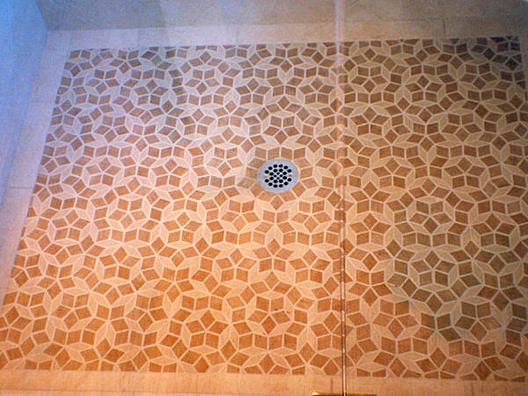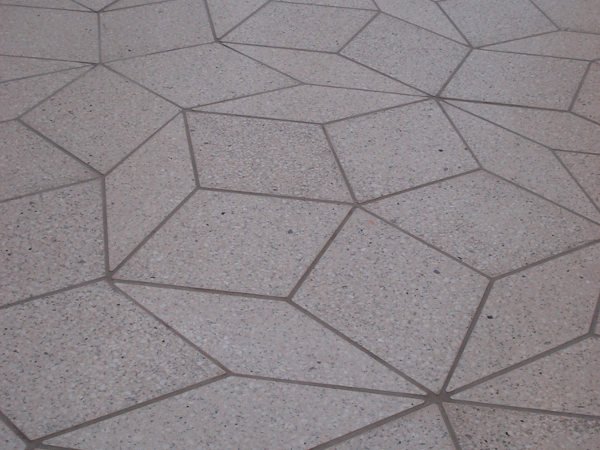Originally published at: https://boingboing.net/2020/10/02/the-astonishing-math-behind-penrose-tilings.html
…
Yeah, lovely stuff, but I’m still looking for the non-repeating tiling that is guaranteed to exactly tile a rectangular region.
Cutting Penrose tiles at the edges of the bathroom wall would be a pain… 
When I tiled my downstairs a few years back, I looked for anyone selling ceramic Penrose tiles.
The only ones I found were from artists. The prices were correspondingly outrageous.
I would have loved to use them, but going bespoke was just too expensive.
My first thought, too (after mind was blown) was can I get some ceramic Penrose tiles to do my bathroom.
@Simon_Clift - but at least it could be done
@joed - that’s what I feared.
Surely there’s a market out there - i.e the maths geek market segment?
Ignoring for the moment that no room in my house is perfectly square and the bathroom has all sorts of obstacles in it you’d have to cut around: I wonder if a Penrose-style tiling would be done differently?
Normally, you’d hide the sloppy and iregular cuts under the baseboard around the room. I could see a Penrose-like tiler working their way in towards the center, though, trying to reduce the number of overall cut tiles, at the risk of having one or two really odd ones in the middle of the room. Toss a bath mat over it and no-one would be the wiser.
In reality, the walls of our place and all the fixtures are such a mathematical disaster that any tile-layer would look at job and triple their price.
In reality, the walls of our place and all the fixtures are such a mathematical disaster that any tile-layer would look at job and triple their price.
Still, I suppose you could program the patterning starting from a group theory library and throw in a little simulated annealing (computer science speak for “muck around at random and see if it gets better”) until you got a decent pattern for the wall or floor. Set the minimizer target function to “no bath mat”. ![]() Put up (or down) a fresh sheet of really solid, appropriately treated, 3/4" plywood for a working base layer and off you go.
Put up (or down) a fresh sheet of really solid, appropriately treated, 3/4" plywood for a working base layer and off you go.
It’s definitely a DIY ![]() quite probably even down to making the tiles themselves. That said, if you’re baking your own porcelain tiles there’s a lot of room for adventure and creativity.
quite probably even down to making the tiles themselves. That said, if you’re baking your own porcelain tiles there’s a lot of room for adventure and creativity.
My father-in-law does some amazing stuff with epoxy on turned wood (retired paint chemist); I’ve seen epoxy used as tile material. If it’s not the floor you might get away with acrylic.
I’m partial to glass myself, but I suppose my user icon makes that fairly clear… ![]()
Y’all are solving the wrong problem. The simpler solution: make the bathroom penrose-tiling shaped.
The simpler solution: make the bathroom penrose-tiling shaped.
![]() Not sure about that… framing that and putting up the wallboard (especially if it’s that concrete stuff) is going to be tricky, never mind getting the taping and finish looking decent…
Not sure about that… framing that and putting up the wallboard (especially if it’s that concrete stuff) is going to be tricky, never mind getting the taping and finish looking decent…
It may be hard, but it’s not NP-hard, amirite?
Mathematical pedantry warning!
I know you were being ironic, but of course you’ll wait a long time. Any rectangle tiles the plane periodically. For what it’s worth, its symmetry group is the dihedral group D2 (equivalently, the Klein 4-group K4 or the product group Z22).
“Where’s the toilet?”
“Left, left again, right, left, right, and right.”
Yeah, but we would only need to get a single period of a set of non-rectangular tiles completely filling a rectangular region. Obviously this would not be a true nonperiodic tiling. But it’s an interesting question in itself: is there a set of { 1< n < tinyint number of } tiles that perfectly tesselates a rectangle in a way that has some of the quality of nonperiodicity? It might be a challenge to define what that means mathematically without it being trivially uninteresting, though.
looking for the non-repeating tiling that is guaranteed to exactly tile a rectangular region.
Well … if the tiles were small enough, and you could tolerate some beading overlaid at the edges…
Mathematical dad-joke warning.
What’s hot and chunky and acts on a polygon? A dihedral soup.
But it’s an interesting question in itself: is there a set of { 1< n < tinyint number of } tiles that perfectly tesselates a rectangle in a way that has some of the quality of nonperiodicity?
The Wang tiles, maybe?
@wazroth It may be hard, but it’s not NP-hard, amirite?
Well said, well said ![]() …
…
But it’s an interesting question in itself: is there a set of { 1< n < tinyint number of } tiles that perfectly tesselates a rectangle in a way that has some of the quality of nonperiodicity?
Beat me to it!
So you’d need some interface between group theory and the kind of adaptive mesh generation (decidedly ad-hoc) in a closed space that fluid dynamics folks use. I wonder if you could treat this as tiling in from a line? Damn… I know a guy at MIT who would probably eat this problem for breakfast.
@kennykb The Wang tiles, maybe?
That’s more of a colouring problem given a grid, though… I want funky geometry…
I wonder if you could treat this as tiling in from a line?
If there were some sort of variant that was tiling in from two perpendicular edges, then you’d only have to cut tiles along two walls. I would predict in a case like this that there’d be a special tile to use just at the vertex, which also seems like a bit of a cheat.
Liked merely for ‘funky geometry’
The stuff in the middle of your post went … whooooosh!
… whooooosh!
The real fun begins with the whoosh part, though ![]() …
…
I’ll settle for funky geometry because my wife is a professional artist who can apparently see more than the 6 colours that I can ![]() and can help me finish the design…
and can help me finish the design…
She can also tile and do epoxy grout…
Found this. Rubber for floors and not penrosey - but a tad funky
ETA I found it here. Interesting take on Penrose being a sueball thrower re copyright
Anybody manufacture actual Penrose tiles? | Hacker News
If you can bear Pinterest (I cannot but the link went there) there is some alleged Penrosishness but it seems not to be entirely true

Penrose Tile Shower Floor | Flooring, Penrose, Tiled quilt
Jul 25, 2012 - Penrose tile floors...these are interesting... The Mud Box
The conclusion here seems to be 'cut your own

Penrose tile floors | Make:
A Penrose tiling (Wikipedia), named for British mathematical physicist Sir Roger Penrose, who investigated them in the 1970s. A Penrose tiling is "aperiodic," or, simply put, produces a pattern that does not repeat itself no matter how far you extend...
